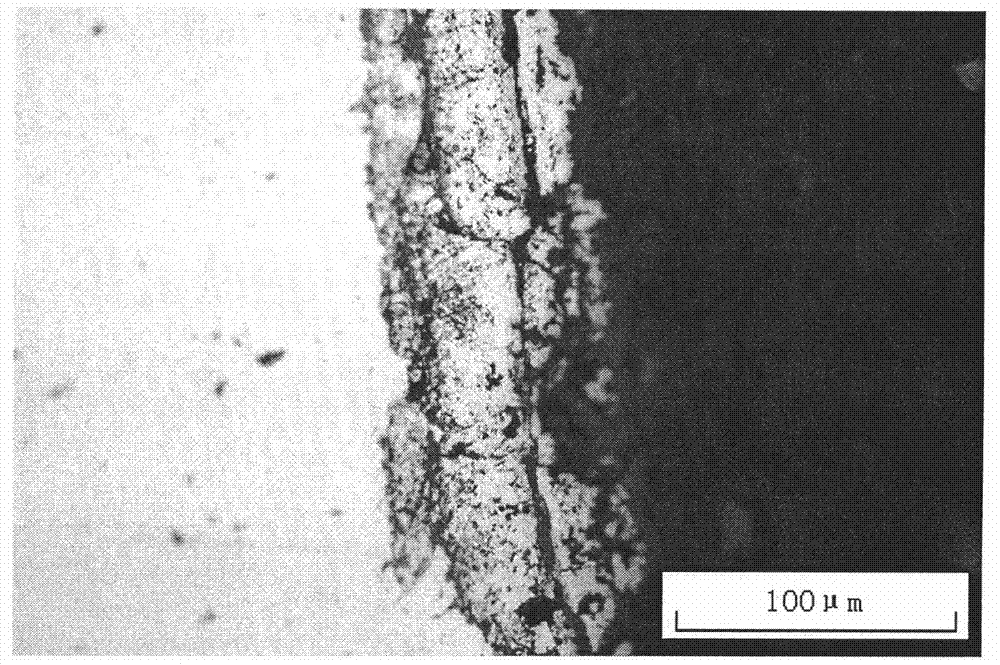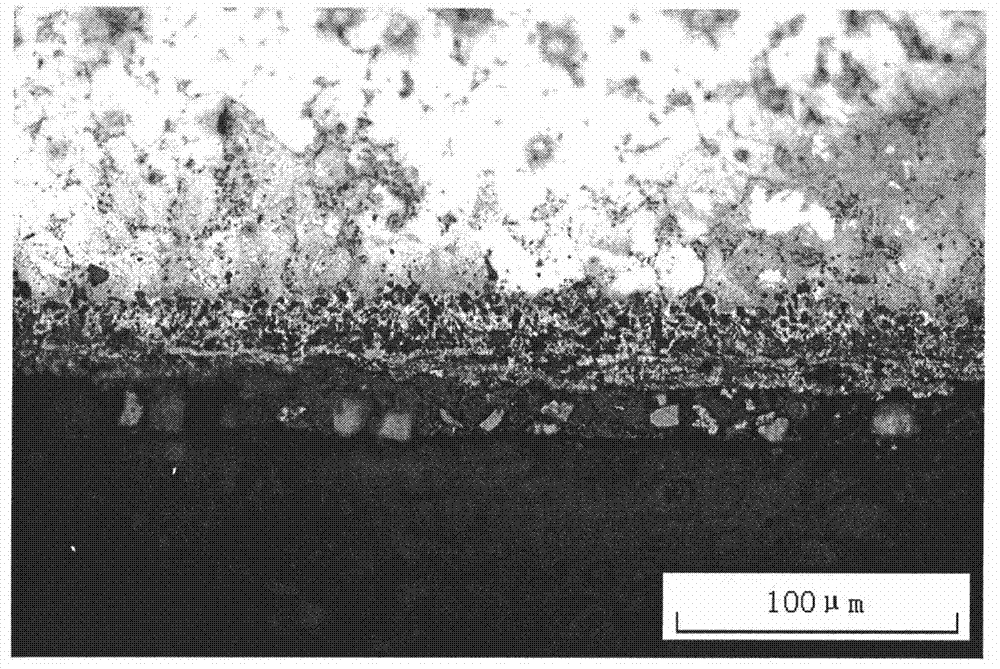Novel low-temperature solid boronizing activator
An activator and low-temperature technology, applied in the direction of solid-state diffusion coating, metal material coating process, coating, etc., can solve the problems of large deformation, large gas volume, long time, etc., and achieve enhanced activity of boron atoms and increased diffusion rate , The effect of small workpiece deformation
- Summary
- Abstract
- Description
- Claims
- Application Information
AI Technical Summary
Problems solved by technology
Method used
Image
Examples
Embodiment 1
[0030] Embodiment 1: A kind of novel low-temperature solid boronizing activator, its component content by mass ratio is: potassium fluoroborate 12.6 parts, cryolite (Na5AlF6) 35.8 parts, calcium fluoride (CaF2) 23.0 parts, urea 14.8 parts.
[0031] The No. 20 steel sample was subjected to rolling treatment before infiltration. The rolling treatment parameters were 4Mpa and 1600r / min, and then boron-chromium-rare earth co-infiltration was carried out under the condition of 600℃×6h, and the sample was observed after infiltration. The process is as follows:
[0032] 1. Carry out pre-infiltration rolling treatment on the workpiece
[0033] The workpiece is rolled at 4Mpa and 1600r / min, and the rolling time is 60min.
[0034] 2. Activator preparation
[0035] The activator is prepared according to the above ratio, and the preparation process is as follows:
[0036] a. Grinding cryolite and calcium fluoride into 120 meshes;
[0037] b. Mix the components of the activator in a ac...
Embodiment 2
[0046] Embodiment 2: A kind of novel low-temperature solid boronizing activator, its component content by mass ratio is: potassium fluoroborate 16.6 parts, cryolite (Na5AlF6) 38.9 parts, calcium fluoride (CaF2) 25.8 parts, urea 18.7 parts.
[0047] The No. 20 steel sample was subjected to rolling treatment before infiltration. The rolling treatment parameters were 4Mpa and 1600r / min, and then boron-chromium-rare earth co-infiltration was carried out under the condition of 650℃×6h, and the sample was observed after infiltration. The process is as follows:
[0048] 1. Carry out pre-infiltration rolling treatment on the workpiece
[0049] The workpiece is rolled at 4Mpa and 1600r / min, and the rolling time is 60min.
[0050] 2. Activator preparation
[0051] The activator is prepared according to the above ratio, and the preparation process is as follows:
[0052] a. Grinding cryolite and calcium fluoride into 120 meshes;
[0053] b. Mix the components of the activator in a ac...
Embodiment 3
[0062] Embodiment 3: A kind of novel low-temperature solid boronizing activator, its component content by mass ratio is: potassium fluoroborate 16.4 parts, cryolite (Na5AlF6) 39.2 parts, calcium fluoride (CaF2) 26.6 parts, urea 17.8 parts.
[0063] The No. 45 steel sample was subjected to rolling treatment before infiltration. The rolling treatment parameters were 4Mpa and 1600r / min, and then boron-chromium-rare earth co-infiltration was carried out under the condition of 600℃×6h, and the sample was observed after infiltration. The process is as follows:
[0064] 1. Carry out pre-infiltration rolling treatment on the workpiece
[0065] The workpiece is rolled at 4Mpa and 1600r / min, and the rolling time is 60min.
[0066] 2. Activator preparation
[0067] The activator is prepared according to the above ratio, and the preparation process is as follows:
[0068] a. Grinding cryolite and calcium fluoride into 120 meshes;
[0069] b. Mix the components of the activator in a ac...
PUM
| Property | Measurement | Unit |
|---|---|---|
| Thickness | aaaaa | aaaaa |
| Microhardness | aaaaa | aaaaa |
| Thickness | aaaaa | aaaaa |
Abstract
Description
Claims
Application Information
 Login to View More
Login to View More - R&D
- Intellectual Property
- Life Sciences
- Materials
- Tech Scout
- Unparalleled Data Quality
- Higher Quality Content
- 60% Fewer Hallucinations
Browse by: Latest US Patents, China's latest patents, Technical Efficacy Thesaurus, Application Domain, Technology Topic, Popular Technical Reports.
© 2025 PatSnap. All rights reserved.Legal|Privacy policy|Modern Slavery Act Transparency Statement|Sitemap|About US| Contact US: help@patsnap.com



